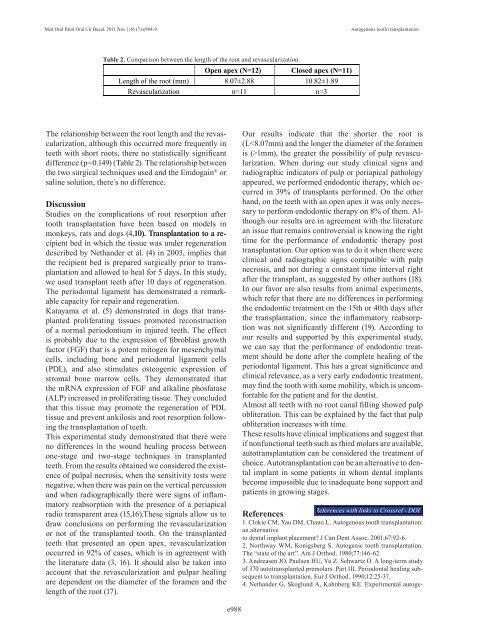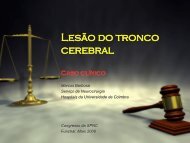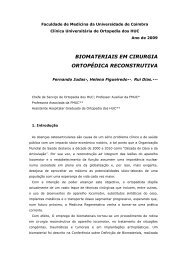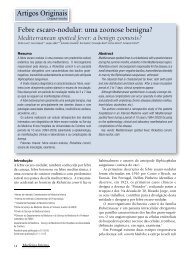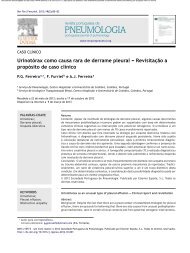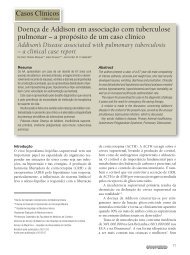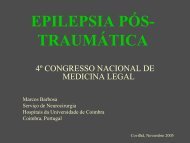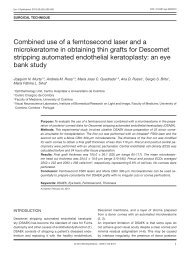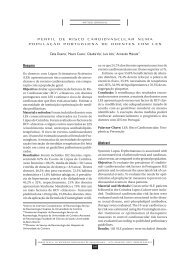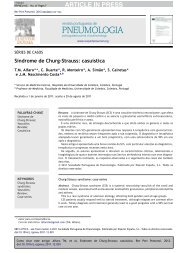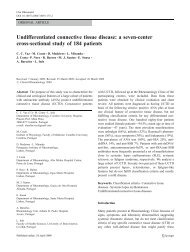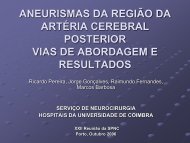Autogenous tooth transplantation: Evaluation of pulp tissue ... - RIHUC
Autogenous tooth transplantation: Evaluation of pulp tissue ... - RIHUC
Autogenous tooth transplantation: Evaluation of pulp tissue ... - RIHUC
Create successful ePaper yourself
Turn your PDF publications into a flip-book with our unique Google optimized e-Paper software.
Med Oral Patol Oral Cir Bucal. 2011 Nov 1;16 (7):e984-9.<strong>Autogenous</strong> <strong>tooth</strong> <strong>transplantation</strong>Table 2. Comparison between the length <strong>of</strong> the root and revascularization.Open apex (N=12)Closed apex (N=11)Length <strong>of</strong> the root (mm) 8.07±2.88 10.82±1.89Revascularization n=11 n=3The relationship between the root length and the revascularization,although this occurred more frequently inteeth with short roots, there no statistically significantdifference (p=0.149) (Table 2). The relationship betweenthe two surgical techniques used and the Emdogain ® orsaline solution, there´s no difference.DiscussionStudies on the complications <strong>of</strong> root resorption after<strong>tooth</strong> <strong>transplantation</strong> have been based on models inmonkeys, rats and dogs (4,10). Transplantation to a recipientbed in which the <strong>tissue</strong> was under regenerationdescribed by Nethander et al. (4) in 2003, implies thatthe recipient bed is prepared surgically prior to <strong>transplantation</strong>and allowed to heal for 5 days. In this study,we used transplant teeth after 10 days <strong>of</strong> regeneration.The periodontal ligament has demonstrated a remarkablecapacity for repair and regeneration.Katayama et al. (5) demonstrated in dogs that transplantedproliferating <strong>tissue</strong>s promoted reconstruction<strong>of</strong> a normal periodontium in injured teeth. The effectis probably due to the expression <strong>of</strong> fibroblast growthfactor (FGF) that is a potent mitogen for mesenchymalcells, including bone and periodontal ligament cells(PDL), and also stimulates osteogenic expression <strong>of</strong>stromal bone marrow cells. They demonstrated thatthe mRNA expression <strong>of</strong> FGF and alkaline phosfatase(ALP) increased in proliferating <strong>tissue</strong>. They concludedthat this <strong>tissue</strong> may promote the regeneration <strong>of</strong> PDL<strong>tissue</strong> and prevent ankilosis and root resorption followingthe <strong>transplantation</strong> <strong>of</strong> teeth.This experimental study demonstrated that there wereno differences in the wound healing process betweenone-stage and two-stage techniques in transplantedteeth. From the results obtained we considered the existence<strong>of</strong> <strong>pulp</strong>al necrosis, when the sensitivity tests werenegative, when there was pain on the vertical percussionand when radiographically there were signs <strong>of</strong> inflammatoryreabsorption with the presence <strong>of</strong> a periapicalradio transparent area (15,16).These signals allow us todraw conclusions on performing the revascularizationor not <strong>of</strong> the transplanted <strong>tooth</strong>. On the transplantedteeth that presented an open apex, revascularizationoccurred in 92% <strong>of</strong> cases, which is in agreement withthe literature data (3, 16). It should also be taken intoaccount that the revascularization and <strong>pulp</strong>ar healingare dependent on the diameter <strong>of</strong> the foramen and thelength <strong>of</strong> the root (17).Our results indicate that the shorter the root is(L1mm), the greater the possibility <strong>of</strong> <strong>pulp</strong> revascularization.When during our study clinical signs andradiographic indicators <strong>of</strong> <strong>pulp</strong> or periapical pathologyappeared, we performed endodontic therapy, which occurredin 39% <strong>of</strong> transplants performed. On the otherhand, on the teeth with an open apex it was only necessaryto perform endodontic therapy on 8% <strong>of</strong> them. Althoughour results are in agreement with the literaturean issue that remains controversial is knowing the righttime for the performance <strong>of</strong> endodontic therapy post<strong>transplantation</strong>. Our option was to do it when there wereclinical and radiographic signs compatible with <strong>pulp</strong>necrosis, and not during a constant time interval rightafter the transplant, as suggested by other authors (18).In our favor are also results from animal experiments,which refer that there are no differences in performingthe endodontic treatment on the 15th or 40th days afterthe <strong>transplantation</strong>, since the inflammatory reabsorptionwas not significantly different (19). According toour results and supported by this experimental study,we can say that the performance <strong>of</strong> endodontic treatmentshould be done after the complete healing <strong>of</strong> theperiodontal ligament. This has a great significance andclinical relevance, as a very early endodontic treatment,may find the <strong>tooth</strong> with some mobility, which is uncomfortablefor the patient and for the dentist.Almost all teeth with no root canal filling showed <strong>pulp</strong>obliteration. This can be explained by the fact that <strong>pulp</strong>obliteration increases with time.These results have clinical implications and suggest thatif nonfunctional teeth such as third molars are available,auto<strong>transplantation</strong> can be considered the treatment <strong>of</strong>choice. Auto<strong>transplantation</strong> can be an alternative to dentalimplant in some patients in whom dental implantsbecome impossible due to inadequate bone support andpatients in growing stages.References with links to Crossref - DOIReferences1. Clokie CM, Yau DM, Chano L. <strong>Autogenous</strong> <strong>tooth</strong> <strong>transplantation</strong>:an alternativeto dental implant placement? J Can Dent Assoc. 2001;67:92-6.2. Northway WM, Konigsberg S. Autogenic <strong>tooth</strong> <strong>transplantation</strong>.The “state <strong>of</strong> the art”. Am J Orthod. 1980;77:146-62.3. Andreasen JO, Paulsen HU, Yu Z, Schwartz O. A long-term study<strong>of</strong> 370 autotransplanted premolars. Part III. Periodontal healing subsequentto <strong>transplantation</strong>. Eur J Orthod. 1990;12:25-37.4. Nethander G, Skoglund A, Kahnberg KE. Experimental autoge-e988


